6 species of frogs discovered in Laos
Rhett A. Butler, mongabay.com
April 20, 2006
Six new species of frogs have been discovered in the Southeast Asia nation of Lao PDR, according to the Bronx Zoo-based Wildlife Conservation Society (WCS).
Three newly discovered frog species are described in the recent issue of Copeia, the journal of the American Society of Herpetologists and Ichthyologists. WCS says that little is known about the new frogs, other than the location they were found and how the compare morphologically to similar species.
“Now that these species have been documented we can go back and start to learn something about their biology,” said Bryan Stuart of the Field Museum, a co-author of the study. Scientists from the American Museum of Natural History and Russian Academy of Sciences were also involved in the new study.
Laos, the least densely populated country in Asia, has produced several wildlife discoveries in recent years, including the Laotian rock rat, described last year. WCS notes that nine amphibians have been discovered by Stuart and his collaborators since 2002, but that these are threatened by habitat destruction and the illegal wildlife trade.
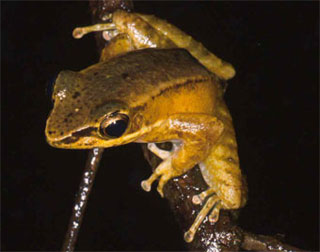 Rana khalam. Photo by Nikolai Orlov 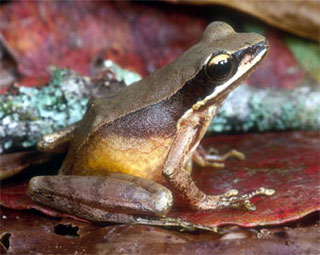 Rana compotrix frog. Photo by Nikolai Orlov 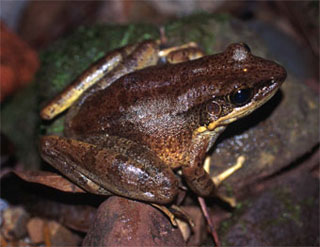 Rana heatwolei frog. Photo by Bryan Stuart. 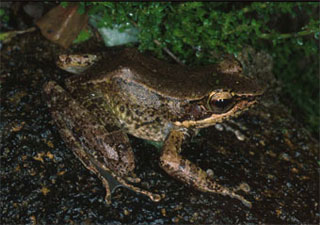 Rana khalam frog. Photo by Nikolai Orlov 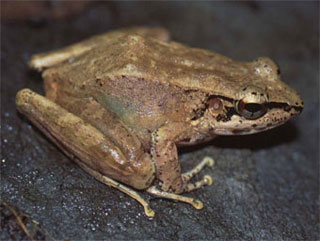 Huia absita frog. Photo by Bryan Stuart.  Paramesotriton laoensi salamander. Photo by Bryan Stuart. |
The discoveries come as amphibian populations are in decline worldwide. A study released earlier this year suggests that climate change is directly responsible for worsening infections caused by a skin fungus. This infectious disease — a type of chytrid fungus (Batrachochytrium dendrobatidis)—is now found in frog populations around the world and is the main suspect in the rapid disappearance of amphibians.
Last year, the Global Amphibian Assessment, a survey of the planet’s amphibian species, found that nearly a third (32%) of the world’s 5743 known amphibian species are threatened and 129 species have gone extinct since 1980. Among the species to disappear is Costa Rica’s Golden toad (Bufo periglenes) and the Gastric Brooding Frog (Rheobatrachus silus) of Queensland, Australia. Scientists believe there may be around 10,000 amphibian species on the planet, although this number is likely to be falling fast.
Despite declining habitat and wildlife populations in Asia, scientists continue to make new discoveries in the forests of the region, including 361 new species in Borneo over the past decade and 43 new species of vertebrates in Sri Lanka. Just last year, scientists with the World Wildlife Fund (WWF) captured on film what may be a new species of mammal in the rainforests of Kalimantan in Indonesian Borneo. The fox-like creature is apparently unknown even to local hunters.
“Certainly much more remains to be found in Laos,” said Stuart.
RELATED ARTICLES
Climate change is killing frogs finds new research January 11, 2006
The dramatic global decline of amphibians may be directly connected to global warming warns a new study published in the journal Nature. Looking at a group of frogs found in biodiversity hotspots in Central and South America, scientists found links between higher temperatures and frog extinctions caused by a skin fungus. The infectious skin disease—a type of chytrid fungus (Batrachochytrium dendrobatidis)—is now found in frog populations around the world and is the main suspect in the rapid disappearance of amphibians.
Fungus may be devastating amphibian populations worldwide February 6, 2006
What is killing the world’s frogs and salamanders? Zoologist Karen R. Lips of Southern Illinois University Carbondale can’t put the cuffs on just yet, but she says her research team has “narrowed the list of suspects” in what scientists call “enigmatic” declines — those that lack an obvious cause. Her most likely culprit is a hugely infectious disease caused by a fungus. In just four months — from mid-September of 2004 to mid-January of 2005 — Lips and her colleagues saw more than half the amphibian population of El Copé, Panama, sicken and die from this disease.
Conservation scientists want $404 million to save disappearing amphibians September 20, 2005
Yesterday conservation scientists proposed a $404 million effort to preserve declining global amphibian poplations. The strategy would call for funding from governments, private institutions and individual donors to finance long-term research, protect critical habitats, reduce the trade in amphibians for food and pets, and establish captive breeding programs.
Study discovers why poison dart frogs are toxic August 9, 2005
Poison poison dart frogs are small, colorful frogs found in the tropical forests of Central and South America. The brilliant coloration of these amphibians warns predators of their extraordinary toxicity — the golden poison frog (Phyllobates terribilis) of Colombia is said to be lethal if held in one’s hand.
16% of frogs species in Sri Lanka may be gone, new survey finds July 2, 2005
In a study published Thursday in Raffles Bulletin of Zoology, researchers confirmed the discovery of 35 new frog species in Sri Lanka over the past decade brining the number of frog species in the island country to 105. However, the survey found that 17 of these species have disappeared and at least another 11 face imminent extinction unless their habitat is protected.
Toad on brink of extinction, scientists race to study amphibian for bioactive compounds June 29, 2005
Under the bright florescent lights of the reptile house in the Bronx Zoo of New York, a colorful exotic toad makes its final stand. Once gathering by the thousands at the waterfalls of the Kihansi Gorge of Tanzania, the population of the Kihansi Spray Toad now stands at less than 200 individuals. The hasty construction of a desperately needed dam, built with good intentions by the World Bank, has relegated this species to the edge of existence. A decade ago the Kihansi Spray Toad thrived in its thoroughly unique habitat, the waterfalls of the Kihansi River, part of ecosystem that is one of only 25 Global Biodiversity Hotspots on the planet (Hotspots are regions noted for their extensive range of species in a very small area). The gorge is located in the Southern Udzungwa Mountains of South Central Tanzania, which possess the greatest biodiversity in all of Tanzania.
This article used information from WCS.